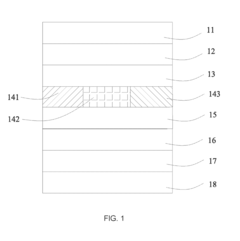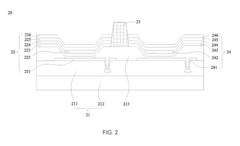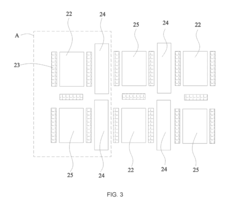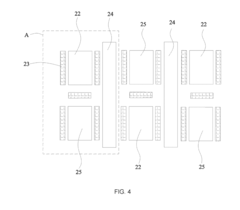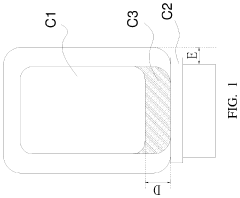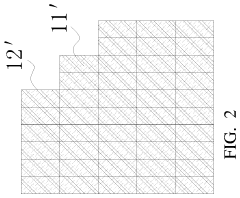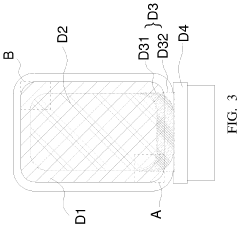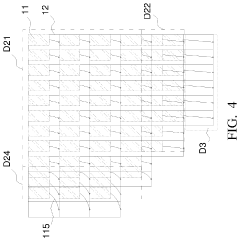How self-luminescence sets AMOLED apart in display tech?
JUL 17, 20258 MIN READ
Generate Your Research Report Instantly with AI Agent
Patsnap Eureka helps you evaluate technical feasibility & market potential.
AMOLED Self-Luminescence Evolution
The evolution of AMOLED self-luminescence technology has been a pivotal factor in revolutionizing display technology. This journey began in the late 1980s with the development of organic light-emitting diodes (OLEDs), which laid the foundation for AMOLED displays.
In the early 2000s, the first AMOLED displays emerged, offering superior contrast and color reproduction compared to traditional LCD screens. These early iterations, however, faced challenges in terms of lifespan and production costs. The self-luminescent nature of AMOLED pixels allowed for true blacks and infinite contrast ratios, setting it apart from backlit technologies.
By the mid-2000s, significant advancements in organic materials and manufacturing processes led to improved efficiency and longevity of AMOLED displays. This period saw the introduction of phosphorescent materials, which greatly enhanced the energy efficiency of blue subpixels, a long-standing challenge in OLED technology.
The late 2000s and early 2010s marked a turning point for AMOLED technology. Manufacturers began incorporating AMOLED displays into smartphones and other portable devices, capitalizing on their energy efficiency and vibrant color reproduction. This era also saw the development of flexible AMOLED panels, opening up new possibilities for device form factors.
From 2015 onwards, AMOLED technology has seen rapid advancements in resolution, color accuracy, and energy efficiency. The introduction of HDR (High Dynamic Range) capabilities further showcased the advantages of self-luminescent displays, offering unparalleled contrast and brightness levels.
Recent years have witnessed the emergence of foldable and rollable AMOLED displays, pushing the boundaries of device design and user interaction. These innovations leverage the inherent flexibility of OLED materials, a unique characteristic that sets AMOLED apart from other display technologies.
Looking ahead, the evolution of AMOLED self-luminescence continues to focus on addressing remaining challenges such as blue pixel degradation and enhancing overall panel lifespan. Research into new organic materials and pixel structures promises to further improve efficiency and color accuracy, solidifying AMOLED's position as a leading display technology.
In the early 2000s, the first AMOLED displays emerged, offering superior contrast and color reproduction compared to traditional LCD screens. These early iterations, however, faced challenges in terms of lifespan and production costs. The self-luminescent nature of AMOLED pixels allowed for true blacks and infinite contrast ratios, setting it apart from backlit technologies.
By the mid-2000s, significant advancements in organic materials and manufacturing processes led to improved efficiency and longevity of AMOLED displays. This period saw the introduction of phosphorescent materials, which greatly enhanced the energy efficiency of blue subpixels, a long-standing challenge in OLED technology.
The late 2000s and early 2010s marked a turning point for AMOLED technology. Manufacturers began incorporating AMOLED displays into smartphones and other portable devices, capitalizing on their energy efficiency and vibrant color reproduction. This era also saw the development of flexible AMOLED panels, opening up new possibilities for device form factors.
From 2015 onwards, AMOLED technology has seen rapid advancements in resolution, color accuracy, and energy efficiency. The introduction of HDR (High Dynamic Range) capabilities further showcased the advantages of self-luminescent displays, offering unparalleled contrast and brightness levels.
Recent years have witnessed the emergence of foldable and rollable AMOLED displays, pushing the boundaries of device design and user interaction. These innovations leverage the inherent flexibility of OLED materials, a unique characteristic that sets AMOLED apart from other display technologies.
Looking ahead, the evolution of AMOLED self-luminescence continues to focus on addressing remaining challenges such as blue pixel degradation and enhancing overall panel lifespan. Research into new organic materials and pixel structures promises to further improve efficiency and color accuracy, solidifying AMOLED's position as a leading display technology.
Market Demand for AMOLED Displays
The market demand for AMOLED displays has been experiencing significant growth in recent years, driven by the technology's superior performance characteristics and expanding applications across various industries. AMOLED's self-luminescent properties have positioned it as a premium display technology, particularly in high-end consumer electronics and automotive sectors.
In the smartphone market, AMOLED displays have become a key differentiator for flagship devices. Major manufacturers like Samsung, Apple, and Huawei have increasingly adopted AMOLED technology for their premium models, capitalizing on its ability to deliver vibrant colors, deep blacks, and energy efficiency. This trend has created a ripple effect, with mid-range smartphone makers also incorporating AMOLED displays to stay competitive.
The wearable technology sector has emerged as another significant driver of AMOLED demand. Smartwatches and fitness trackers benefit greatly from AMOLED's power efficiency and readability in various lighting conditions. As the wearable market continues to expand, the demand for AMOLED displays in this segment is expected to grow proportionally.
In the automotive industry, AMOLED displays are gaining traction for use in infotainment systems and digital dashboards. The technology's high contrast ratio and wide viewing angles make it ideal for in-vehicle displays, enhancing both aesthetics and functionality. As vehicles become more connected and autonomous, the demand for advanced display technologies like AMOLED is projected to increase substantially.
The television market has also shown a growing appetite for AMOLED technology, particularly in the high-end segment. AMOLED TVs offer superior picture quality, including perfect blacks and infinite contrast ratios, appealing to consumers seeking premium viewing experiences. While OLED TVs currently represent a smaller portion of the overall TV market, their share is steadily increasing as production costs decrease and consumer awareness grows.
Emerging applications in virtual and augmented reality (VR/AR) devices present another avenue for AMOLED market expansion. The technology's fast response times and high refresh rates are crucial for reducing motion sickness and providing immersive experiences in VR/AR applications. As these technologies mature and find wider adoption in both consumer and enterprise markets, the demand for AMOLED displays in this sector is expected to surge.
Despite the growing demand, challenges remain in the AMOLED market. Production costs, while decreasing, are still higher than those of traditional LCD displays. This cost differential has limited AMOLED's penetration in certain price-sensitive market segments. Additionally, concerns about burn-in and lifespan issues persist, although technological advancements continue to address these challenges.
In the smartphone market, AMOLED displays have become a key differentiator for flagship devices. Major manufacturers like Samsung, Apple, and Huawei have increasingly adopted AMOLED technology for their premium models, capitalizing on its ability to deliver vibrant colors, deep blacks, and energy efficiency. This trend has created a ripple effect, with mid-range smartphone makers also incorporating AMOLED displays to stay competitive.
The wearable technology sector has emerged as another significant driver of AMOLED demand. Smartwatches and fitness trackers benefit greatly from AMOLED's power efficiency and readability in various lighting conditions. As the wearable market continues to expand, the demand for AMOLED displays in this segment is expected to grow proportionally.
In the automotive industry, AMOLED displays are gaining traction for use in infotainment systems and digital dashboards. The technology's high contrast ratio and wide viewing angles make it ideal for in-vehicle displays, enhancing both aesthetics and functionality. As vehicles become more connected and autonomous, the demand for advanced display technologies like AMOLED is projected to increase substantially.
The television market has also shown a growing appetite for AMOLED technology, particularly in the high-end segment. AMOLED TVs offer superior picture quality, including perfect blacks and infinite contrast ratios, appealing to consumers seeking premium viewing experiences. While OLED TVs currently represent a smaller portion of the overall TV market, their share is steadily increasing as production costs decrease and consumer awareness grows.
Emerging applications in virtual and augmented reality (VR/AR) devices present another avenue for AMOLED market expansion. The technology's fast response times and high refresh rates are crucial for reducing motion sickness and providing immersive experiences in VR/AR applications. As these technologies mature and find wider adoption in both consumer and enterprise markets, the demand for AMOLED displays in this sector is expected to surge.
Despite the growing demand, challenges remain in the AMOLED market. Production costs, while decreasing, are still higher than those of traditional LCD displays. This cost differential has limited AMOLED's penetration in certain price-sensitive market segments. Additionally, concerns about burn-in and lifespan issues persist, although technological advancements continue to address these challenges.
AMOLED vs LCD: Technical Challenges
AMOLED (Active-Matrix Organic Light-Emitting Diode) and LCD (Liquid Crystal Display) are two prominent display technologies, each with its unique set of technical challenges. While both aim to deliver high-quality visual experiences, their fundamental differences in operation lead to distinct hurdles in development and implementation.
AMOLED displays face challenges in manufacturing complexity and yield rates. The organic materials used in AMOLED are sensitive to oxygen and moisture, requiring stringent production environments. This sensitivity also contributes to potential screen burn-in issues, where static images can leave permanent marks on the display over time. Additionally, AMOLED screens struggle with color accuracy and consistency across different brightness levels, often exhibiting a blue shift at lower brightness settings.
On the other hand, LCD technology grapples with power efficiency, especially in displaying dark content. The backlight in LCD screens remains constantly lit, even when displaying black, leading to higher energy consumption compared to AMOLED. LCD also faces challenges in achieving true blacks and high contrast ratios due to light leakage through the liquid crystal layer. Response times in LCD panels can be slower, potentially resulting in motion blur during fast-moving scenes.
Both technologies encounter difficulties in scaling to larger sizes while maintaining uniformity and cost-effectiveness. For AMOLED, increasing panel size amplifies the complexity of the organic material deposition process. LCD struggles with maintaining consistent backlighting across larger surfaces, often resulting in visible light bleed at the edges.
Heat management presents another shared challenge. AMOLED displays generate heat at the pixel level, which can affect the longevity of the organic materials. LCD screens, with their backlight systems, must efficiently dissipate heat to prevent damage to the liquid crystals and maintain optimal performance.
In terms of lifespan, AMOLED displays typically have shorter overall lifespans compared to LCD, partly due to the degradation of organic materials over time. This degradation can lead to uneven wear and color shifts across the display. LCD technology, while generally more durable, can suffer from issues such as stuck pixels and backlight deterioration over extended periods of use.
Both technologies also face challenges in outdoor visibility. AMOLED displays can struggle with reflectivity and sunlight readability, while LCD screens often require increased backlight intensity to compete with ambient light, further impacting power efficiency.
AMOLED displays face challenges in manufacturing complexity and yield rates. The organic materials used in AMOLED are sensitive to oxygen and moisture, requiring stringent production environments. This sensitivity also contributes to potential screen burn-in issues, where static images can leave permanent marks on the display over time. Additionally, AMOLED screens struggle with color accuracy and consistency across different brightness levels, often exhibiting a blue shift at lower brightness settings.
On the other hand, LCD technology grapples with power efficiency, especially in displaying dark content. The backlight in LCD screens remains constantly lit, even when displaying black, leading to higher energy consumption compared to AMOLED. LCD also faces challenges in achieving true blacks and high contrast ratios due to light leakage through the liquid crystal layer. Response times in LCD panels can be slower, potentially resulting in motion blur during fast-moving scenes.
Both technologies encounter difficulties in scaling to larger sizes while maintaining uniformity and cost-effectiveness. For AMOLED, increasing panel size amplifies the complexity of the organic material deposition process. LCD struggles with maintaining consistent backlighting across larger surfaces, often resulting in visible light bleed at the edges.
Heat management presents another shared challenge. AMOLED displays generate heat at the pixel level, which can affect the longevity of the organic materials. LCD screens, with their backlight systems, must efficiently dissipate heat to prevent damage to the liquid crystals and maintain optimal performance.
In terms of lifespan, AMOLED displays typically have shorter overall lifespans compared to LCD, partly due to the degradation of organic materials over time. This degradation can lead to uneven wear and color shifts across the display. LCD technology, while generally more durable, can suffer from issues such as stuck pixels and backlight deterioration over extended periods of use.
Both technologies also face challenges in outdoor visibility. AMOLED displays can struggle with reflectivity and sunlight readability, while LCD screens often require increased backlight intensity to compete with ambient light, further impacting power efficiency.
Current AMOLED Display Solutions
01 AMOLED pixel structure and driving method
AMOLED displays utilize self-luminous pixels, each containing organic light-emitting diodes. The pixel structure and driving methods are designed to control the light emission of individual pixels, improving display quality and energy efficiency. This includes techniques for managing pixel circuits, addressing schemes, and compensation mechanisms for uniform brightness.- AMOLED display structure and fabrication: AMOLED displays are self-luminescent, consisting of organic light-emitting diodes arranged in an active matrix. The structure includes multiple layers such as a substrate, thin-film transistors, organic light-emitting materials, and encapsulation. Fabrication techniques focus on improving efficiency, color accuracy, and longevity of the display.
- Pixel circuit design for AMOLED displays: Advanced pixel circuit designs are crucial for AMOLED displays to ensure uniform brightness and color accuracy. These circuits typically include driving transistors, storage capacitors, and compensation mechanisms to address issues like threshold voltage variations and current leakage in OLEDs.
- Power management and energy efficiency in AMOLED displays: AMOLED displays employ various power management techniques to optimize energy consumption. These include adaptive brightness control, selective pixel activation, and advanced driving schemes that balance image quality with power efficiency. Such methods extend battery life in mobile devices while maintaining display performance.
- Touch integration in AMOLED displays: Integrating touch functionality into AMOLED displays presents unique challenges due to the self-luminescent nature of OLEDs. Solutions include in-cell and on-cell touch technologies, which minimize interference between touch sensors and display elements while maintaining the thinness and flexibility advantages of AMOLED screens.
- Color management and image quality enhancement: AMOLED displays utilize advanced color management techniques to achieve wide color gamuts and high contrast ratios. This includes precise control of individual subpixels, implementation of color correction algorithms, and optimization of OLED materials for improved color accuracy and consistency across the display.
02 AMOLED panel manufacturing and materials
The manufacturing process and materials used in AMOLED panels are crucial for their self-luminescent properties. This includes the development of organic light-emitting materials, thin-film transistor (TFT) backplanes, and encapsulation techniques. Innovations in these areas aim to enhance display performance, longevity, and production efficiency.Expand Specific Solutions03 Power management and energy efficiency in AMOLED displays
AMOLED displays offer potential energy savings due to their self-luminous nature. Power management techniques are implemented to optimize energy consumption while maintaining display quality. This includes adaptive brightness control, selective pixel activation, and efficient driving schemes to reduce power consumption in various usage scenarios.Expand Specific Solutions04 AMOLED display integration with touch and biometric sensors
The self-luminous nature of AMOLED displays allows for integration with other functionalities such as touch sensing and biometric sensors. This integration can lead to thinner device profiles and improved user experiences. Techniques are developed to incorporate these sensors without compromising display quality or increasing power consumption.Expand Specific Solutions05 Color management and image quality enhancement in AMOLED displays
AMOLED's self-luminescent properties enable a wide color gamut and high contrast ratios. Techniques are developed to optimize color reproduction, manage color shift, and enhance overall image quality. This includes color calibration methods, gamma correction, and algorithms for HDR content display on AMOLED screens.Expand Specific Solutions
Key AMOLED Display Manufacturers
The AMOLED display technology market is in a mature growth phase, with significant advancements in self-luminescence capabilities setting it apart from traditional display technologies. The global AMOLED market size is projected to reach substantial figures, driven by increasing demand in smartphones, televisions, and wearable devices. Major players like Samsung Display, LG Display, and BOE Technology are leading the technological race, with companies such as Tianma Microelectronics and Visionox Technology also making significant strides. These firms are investing heavily in R&D to enhance AMOLED performance, focusing on aspects like color accuracy, energy efficiency, and flexible display applications. The competitive landscape is intense, with Asian manufacturers dominating the market, while Western companies like IBM contribute through research and patents.
BOE Technology Group Co., Ltd.
Technical Solution: BOE has been rapidly advancing in AMOLED technology, focusing on flexible and foldable displays. They have developed a 6th generation flexible AMOLED production line, capable of producing displays with a curvature radius of less than 1mm[7]. BOE's self-luminescent displays incorporate advanced pixel compensation technology to improve uniformity and reduce color shift at different viewing angles[8]. They have also introduced AMOLED displays with integrated under-display fingerprint sensors, leveraging the technology's self-luminescent properties to enhance biometric security features[9].
Strengths: Rapid advancement in flexible AMOLED technology, large production capacity, and integration of advanced features. Weaknesses: Relatively new entrant in high-end AMOLED market, still catching up in some aspects of color accuracy and power efficiency.
Everdisplay Optronics (Shanghai) Co., Ltd.
Technical Solution: Everdisplay specializes in small and medium-sized AMOLED displays, with a focus on wearables and mobile devices. Their AMOLED technology utilizes advanced pixel compensation algorithms to improve display uniformity and reduce color shift over time[13]. Everdisplay has developed ultra-low power AMOLED displays for smartwatches, leveraging the self-luminescent nature of OLED to achieve always-on display functionality with minimal battery drain[14]. They have also introduced flexible AMOLED panels with a bending radius of up to 1mm, suitable for foldable and rollable device applications[15].
Strengths: Specialization in small and medium-sized displays, advancements in ultra-low power consumption, and flexible display technology. Weaknesses: Limited presence in large-format displays, potentially higher production costs due to smaller scale compared to major competitors.
AMOLED Pixel Structure Innovations
OLED divice and display apparatus
PatentActiveUS20190006435A1
Innovation
- An insulating barrier is provided between adjacent OLED subpixels with different colors to block carrier diffusion, preventing electron and hole migration into adjacent subpixels and thus reducing light-emitting crosstalk and color shifts.
Active matrix organic light-emitting diode display panel
PatentInactiveUS20200185467A1
Innovation
- The AMOLED display panel design includes a driving circuit region with a smaller area than the display light-emitting region, where the display light-emitting region completely covers the driving circuit and fan-out regions, with optimized placement of driving units and display units to reduce the area of the lower edge region and fan-out trace, allowing for a narrower frame.
AMOLED Power Efficiency Analysis
AMOLED (Active-Matrix Organic Light-Emitting Diode) displays have gained significant attention in recent years due to their superior power efficiency compared to traditional LCD technology. This efficiency stems from the self-luminescent nature of OLED pixels, which eliminates the need for a backlight and allows for selective pixel activation.
The power consumption of AMOLED displays is directly proportional to the content being displayed. In dark or black scenes, AMOLED screens consume minimal power as the pixels can be completely turned off. This characteristic is particularly advantageous for mobile devices and applications with predominantly dark interfaces, leading to substantial energy savings.
AMOLED's power efficiency is further enhanced by its ability to produce vibrant colors without the need for color filters. Each pixel in an AMOLED display consists of red, green, and blue sub-pixels that emit light directly, resulting in more accurate color reproduction and reduced power loss compared to LCD technology, which relies on white backlighting and color filters.
The voltage requirements for AMOLED displays are generally lower than those of LCDs, contributing to their overall power efficiency. This is particularly beneficial in battery-powered devices, where power conservation is crucial for extending operational time between charges.
However, it's important to note that AMOLED power efficiency can vary depending on the content displayed. Bright, white scenes may consume more power than on LCD displays, as all sub-pixels need to be activated simultaneously. This variability in power consumption based on content is a unique characteristic of AMOLED technology.
Recent advancements in AMOLED technology have focused on improving power efficiency across all usage scenarios. Manufacturers have implemented various techniques such as more efficient OLED materials, optimized pixel structures, and advanced driving schemes to reduce power consumption while maintaining or enhancing display quality.
The power efficiency of AMOLED displays has significant implications for the design and functionality of modern electronic devices. It enables the development of thinner, lighter devices with longer battery life, particularly beneficial for smartphones, smartwatches, and other portable electronics. Additionally, the energy-saving properties of AMOLED technology align well with the growing emphasis on sustainability and energy conservation in consumer electronics.
The power consumption of AMOLED displays is directly proportional to the content being displayed. In dark or black scenes, AMOLED screens consume minimal power as the pixels can be completely turned off. This characteristic is particularly advantageous for mobile devices and applications with predominantly dark interfaces, leading to substantial energy savings.
AMOLED's power efficiency is further enhanced by its ability to produce vibrant colors without the need for color filters. Each pixel in an AMOLED display consists of red, green, and blue sub-pixels that emit light directly, resulting in more accurate color reproduction and reduced power loss compared to LCD technology, which relies on white backlighting and color filters.
The voltage requirements for AMOLED displays are generally lower than those of LCDs, contributing to their overall power efficiency. This is particularly beneficial in battery-powered devices, where power conservation is crucial for extending operational time between charges.
However, it's important to note that AMOLED power efficiency can vary depending on the content displayed. Bright, white scenes may consume more power than on LCD displays, as all sub-pixels need to be activated simultaneously. This variability in power consumption based on content is a unique characteristic of AMOLED technology.
Recent advancements in AMOLED technology have focused on improving power efficiency across all usage scenarios. Manufacturers have implemented various techniques such as more efficient OLED materials, optimized pixel structures, and advanced driving schemes to reduce power consumption while maintaining or enhancing display quality.
The power efficiency of AMOLED displays has significant implications for the design and functionality of modern electronic devices. It enables the development of thinner, lighter devices with longer battery life, particularly beneficial for smartphones, smartwatches, and other portable electronics. Additionally, the energy-saving properties of AMOLED technology align well with the growing emphasis on sustainability and energy conservation in consumer electronics.
AMOLED Environmental Impact
The environmental impact of AMOLED technology is a crucial consideration in the broader context of display technology sustainability. AMOLED displays offer several advantages that contribute to reduced environmental footprint compared to traditional LCD displays.
One of the primary environmental benefits of AMOLED technology is its energy efficiency. Due to the self-luminous nature of organic light-emitting diodes, AMOLED displays do not require a backlight, resulting in significantly lower power consumption. This energy efficiency translates to extended battery life in mobile devices and reduced electricity usage in larger displays, ultimately leading to decreased energy demand and associated carbon emissions.
The manufacturing process of AMOLED displays also presents potential environmental advantages. AMOLED panels typically require fewer components and layers compared to LCD displays, potentially reducing material usage and simplifying the production process. This streamlined manufacturing approach can lead to reduced waste generation and lower resource consumption during production.
AMOLED displays also offer the potential for improved recyclability. The organic materials used in AMOLED panels are generally more environmentally friendly than the liquid crystals used in LCD displays. Additionally, the simpler structure of AMOLED displays may facilitate easier disassembly and recycling at the end of the product lifecycle.
However, it is important to note that AMOLED technology is not without environmental challenges. The production of organic materials used in AMOLED displays can involve complex chemical processes, which may have associated environmental impacts. Additionally, the shorter lifespan of organic materials compared to inorganic alternatives used in LCDs may lead to more frequent device replacements, potentially increasing electronic waste.
The industry is actively addressing these challenges through ongoing research and development efforts. Innovations in material science are focused on developing more stable and longer-lasting organic compounds, which could extend the lifespan of AMOLED displays and reduce electronic waste. Furthermore, advancements in manufacturing techniques aim to improve production efficiency and reduce the environmental impact of AMOLED panel fabrication.
As AMOLED technology continues to evolve, its environmental impact is likely to improve further. The development of more efficient and sustainable production methods, coupled with advancements in material science, holds promise for reducing the ecological footprint of AMOLED displays throughout their lifecycle. This ongoing progress reinforces the potential of AMOLED technology as a more environmentally friendly option in the display industry.
One of the primary environmental benefits of AMOLED technology is its energy efficiency. Due to the self-luminous nature of organic light-emitting diodes, AMOLED displays do not require a backlight, resulting in significantly lower power consumption. This energy efficiency translates to extended battery life in mobile devices and reduced electricity usage in larger displays, ultimately leading to decreased energy demand and associated carbon emissions.
The manufacturing process of AMOLED displays also presents potential environmental advantages. AMOLED panels typically require fewer components and layers compared to LCD displays, potentially reducing material usage and simplifying the production process. This streamlined manufacturing approach can lead to reduced waste generation and lower resource consumption during production.
AMOLED displays also offer the potential for improved recyclability. The organic materials used in AMOLED panels are generally more environmentally friendly than the liquid crystals used in LCD displays. Additionally, the simpler structure of AMOLED displays may facilitate easier disassembly and recycling at the end of the product lifecycle.
However, it is important to note that AMOLED technology is not without environmental challenges. The production of organic materials used in AMOLED displays can involve complex chemical processes, which may have associated environmental impacts. Additionally, the shorter lifespan of organic materials compared to inorganic alternatives used in LCDs may lead to more frequent device replacements, potentially increasing electronic waste.
The industry is actively addressing these challenges through ongoing research and development efforts. Innovations in material science are focused on developing more stable and longer-lasting organic compounds, which could extend the lifespan of AMOLED displays and reduce electronic waste. Furthermore, advancements in manufacturing techniques aim to improve production efficiency and reduce the environmental impact of AMOLED panel fabrication.
As AMOLED technology continues to evolve, its environmental impact is likely to improve further. The development of more efficient and sustainable production methods, coupled with advancements in material science, holds promise for reducing the ecological footprint of AMOLED displays throughout their lifecycle. This ongoing progress reinforces the potential of AMOLED technology as a more environmentally friendly option in the display industry.
Unlock deeper insights with Patsnap Eureka Quick Research — get a full tech report to explore trends and direct your research. Try now!
Generate Your Research Report Instantly with AI Agent
Supercharge your innovation with Patsnap Eureka AI Agent Platform!
